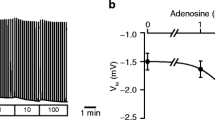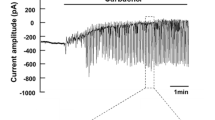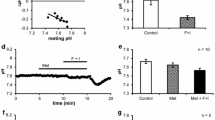Abstract
NaCl secretion in rectal gland tubules (RGT) of Squalus acanthias requires the activation of Cl– channels in the luminal membrane. The RGT and its mechanism of activation are an early evolutionary paradigm of exocrine secretion. The respective Cl– channels probably resemble the shark equivalent of the cystic fibrosis transmembrane conductance regulator (CFTR). Activation of these Cl– channels occurs via cAMP. It has been hypothesized that the activation of CFTR occurs via exocytosis or inhibited endocytosis. To examine this question directly by electrical measurements we have performed whole-cell patch-clamp analyses of in vitro perfused RGT. NaCl secretion was stimulated by a solution (Stim) containing forskolin (10 µmol/l), dibutyryl-cAMP (0.5 mmol/l) and adenosine (0.5 mmol/l). This led to the expected strong depolarization and an increase in membrane conductance (G m). The membrane capacitance (C m) was measured by a newly devised two-frequency synchronous detector method. It was increased by Stim significantly from 5.00±0.22 to 5.17±0.21 pF (n=50). The increase in C m correlated with the increase in G m with a slope of 51 fF/nS. Next the effect of furosemide (500 µmol/l) was examined in previously stimulated RGT. Furosemide was supposed to inhibit coupled Na+2Cl–K+ uptake and to reduce cell volume but not membrane trafficking of Cl– channels. Furosemide reduced G m slightly (due to the fall in cytosolic Cl– concentration) and C m to the same extent by which Stim had increased it. Both changes were statistically significant, and the slope of ΔC m/ΔG m was similar to that caused by Stim. Inhibitors of microtubules or actin (colchicine, phalloidin and cytochalasin D added at 10 µmol/l to the pipette solution and dialysed for >10 min) did not alter cell voltage, G m or C m, nor did these inhibitors abolish the stimulatory effect of cAMP. These data suggest that the small C m changes observed with Stim reflect a minor cell volume increase and an ”unfolding” of the plasma membrane. The present data do not support the exocytosis/endocytosis hypothesis of cAMP-mediated activation of Cl– channels in these cells.
Similar content being viewed by others
Author information
Authors and Affiliations
Additional information
Received: 11 March 1998 / Received after revision 15 April 1998 / Accepted: 20 April 1998
Rights and permissions
About this article
Cite this article
Greger, R., Thiele, I., Warth, R. et al. Does stimulation of NaCl secretion in in vitro perfused rectal gland tubules of Squalus acanthias increase membrane capacitance?. Pflügers Arch 436, 538–544 (1998). https://doi.org/10.1007/s004240050669
Issue Date:
DOI: https://doi.org/10.1007/s004240050669




